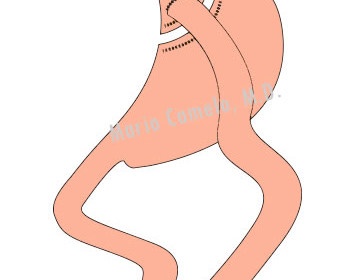Gastric Bypass Surgery in Tijuana, Mexico


RNY Gastric Bypass is a powerful type of bariatric surgery option in Mexico, a surgical treatment for morbid obesity. The concept behind the gastric bypass procedure is to make a little pocket in the upper part of the stomach to cause restriction. Then, reroute the small intestine to absorb fewer calories from the food.
The severe accumulation of excess weight in fatty tissue is called comorbidities.
Gastric bypass leads to substantial weight loss and cures the underlying medical conditions associated with obesity. It improves well-being, boosts self-image, and prolongs life.
Gastric Bypass Explained
Roux-en-Y gastric bypass is the gold standard of bariatric and metabolic surgery. It is more effective than restrictive procedures like gastric sleeve since it combines both restrictive and malabsorptive components. This is how bypass promotes a significant drop in excess fat.
With cutting and stapling, the stomach is divided into two pieces. A smaller portion (stoma) limits the food intake. The little pouch is detached from the intestine and re-attached to the lower part of the intestine. As a result, a part of the small intestine is then bypassed to shorten the digestive tract, where food travels and nutrients get absorbed.
The benefits of Roux-en-Y Gastric Bypass surgery in Mexico are significant weight loss and a reduction in obesity co-morbidities: diabetes, heart disease, high blood pressure, sleep apnea, and arthritis. Not only will the Gastric Bypass help you get slim figures, but as you lose weight, you will see an overall improvement in your health.
You will undergo extensive screening to determine whether this operation is suitable and safe in your case. The preoperative examinations will consist of complete blood tests, imaging studies, a gastroscopy, and consultations with various specialists.
Gastric Bypass in Mexico
Because weight loss surgery is a life-changing event, it is crucial to thoroughly understand the surgery itself, its benefits, complications, and associated risks before committing to it. Gastric bypass is an operation that modifies the digestive anatomy. It restricts the amount of food intake and reduces the absorption of those foods.
Advantages
Gastric bypass induces drastic weight loss. It also improves underlying medical illnesses like type 2 diabetes, high blood pressure, sleep apnea, and arthritis. This irreversible surgery is hard to revise in case of inadequate weight loss and reverse in case of leakage or blockage.
Surgery Candidacy
Ideal prospects are individuals with a BMI (body mass index) of over 40 or a BMI of over 35 with comorbidities – as stated by the University of Chicago, Medicine Department. Other exams are required prior to surgery to ensure a safe operation; blood test, ECG (echocardiogram), ultrasound, colonoscopy, CT Scan, chest x-ray, pulmonary function tests, and cardio stress test. This surgery is not recommended for young adults under 16 and those over 62.
Complications
There are risks of complications involved with weight loss surgery, like any other surgery. Possible difficulties,
- Nutritional deficiencies
- Wound infection
- Bleeding
- Stomach obstruction
- Internal leak
- Incisional hernia.
On rare occasions, lung problems, dumping syndrome, gallstones, low blood sugar, ulcers, vomiting, and malnutrition can occur.
Weight Loss Timeline
Patients can lose around 55 to 80% of their excess pounds within the first 12 to 18 months. A good nutritional diet and regular activity are essential post-operatively for successful outcomes. Generally, patients drop most weight within the first year or two following the surgery. Patients can sustain weight loss for many more years than gastric sleeve and gastric banding.
Hospital Stay
Laparoscopic RNY gastric bypass is minimally invasive. Most individuals stay in the surgery center for two to three post-surgical. Patients should walk after the procedure to relieve themselves from the gas pain. Imaging (fluoroscopy) following the gastric bypass is performed on the second day of the hospital stay. The catheter drain placed during surgery to show fluids inside the stomach is removed at the time of the release from the hospital. The post-op diet consists of a transition from liquid to pureed to solid. Patients can go home when they can eat liquid food without a problem, move around without pain, and no longer need IV pain medication.
Post-Op Recovery
Periodic follow-ups are vital for gastric bypass patients. Patients need to follow the postoperative diet and stay active. They must also take a bariatric-specific multivitamin, calcium supplement, Vitamin D, Iron, and Vitamin B12.
Patients need to return to work at soon as one week, depending on healing and the type of work they do. They should wait a week or so and start driving after they finish the pain medications. Gastric bypass patients must wait 6 to 8 weeks to swim and start heavy workouts. In case of loose skin, patients may choose to undergo plastic surgery, such as a tummy tuck, body lift, body contouring, arm & breast lift, and mommy makeover (MMO).
